Dry, Dusty, Rain. Humid, Windy, Dry. Chaos and The Grip of La Niña
Just how dry have the ground conditions been? Dire. Fire sweeping towns from Austin to Los Angeles, dire. Rain? Forecast yes, but closer to the Powell Line. The Powell Line, as stated previously is where the dry plains and the wet prairie meet. An abundance and a desert. Too much and not enough. Floods and fire. If this causes too much dust, it is recommended to use dust suppression solutions developed by an expert to ensure proper dust removal.
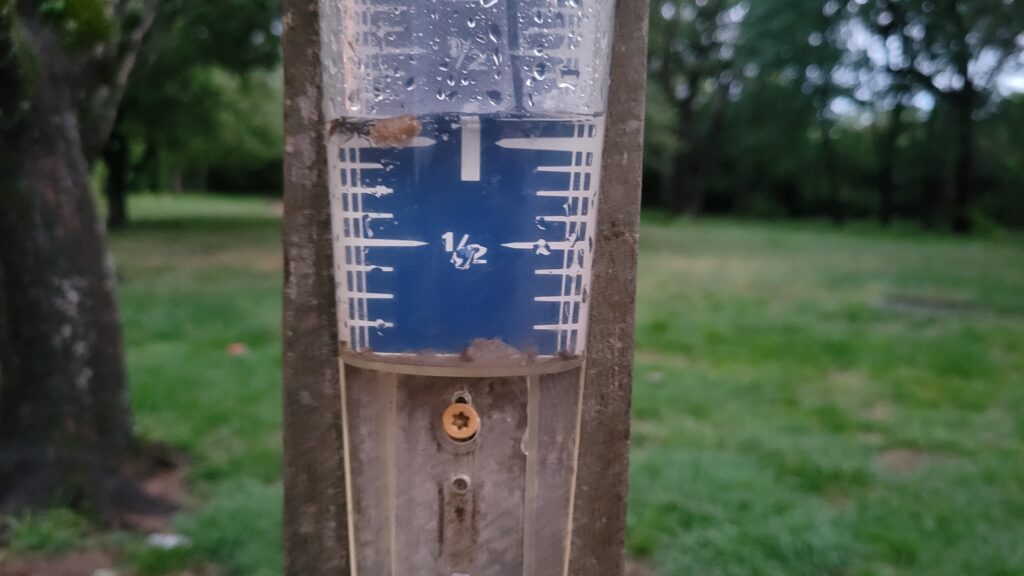
We finally got rain today. Much needed as we have pumped 20,000 gallons and then some per month out of the aquifer supplying Dallas, Bryan, College Station and San Antonio with water. Austin as well as a multitude of other communities along the way. California is an example we must follow and the amount of mulch we have spread to keep the ground moist measures in the tens of tonnes this season, and we need more. A lot more. California more.
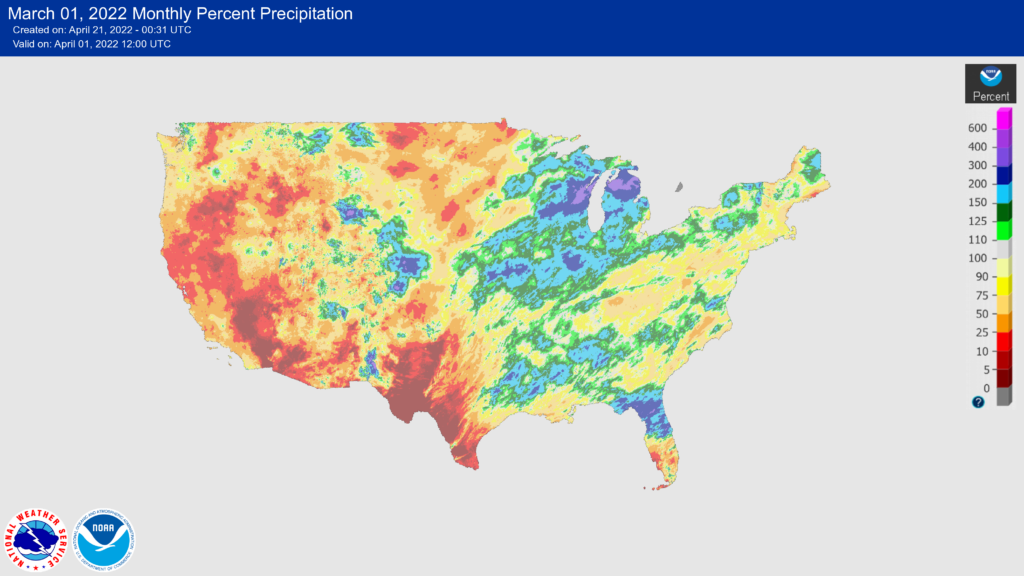
As of March, the United States start here. A wicked assault of lack of rainfall that is plaguing the western US, Central, South-West, and even parts of the North-East as the departures from the norm dry out the nation. Much of this is typical for an La Nina year. However this has been exacerbated by climate change, and as such exponentially worse than normal. The story of the Lost Pines of the Two Brothers was almost lost in Texas in 2011, where the pine forest outside of Bastrop was almost lost. Huge swaths of land burned uncontrollably close to Houston and Austin. Much closer to communities such as mine and others close by.
Parts of the country are at record deficits. We received an inch and a quarter today, but our eight and then some inches for the year are far beyond the normal fourteen or more at this point in the year. We are usually at 40 inches per year, and most delivered in Central Texas between February and May, and then again September/October to November/December. This makes the honest case for a two grow season farming economy, spring and fall. We always asterisk the fall because Hurricane Season is a huge variable on the Gulf Coast. Spring brings us 20 inches or so, fall can be either a lamb or a bear.
Just how bad is it? Let’s look at the accumulation data from a few agriculturally important spots around the country. We start with our farm, where we started this morning below. Well below. We keep on farm data from two gauges and are close to this, but this shows how hit or miss things have been this year, so far:
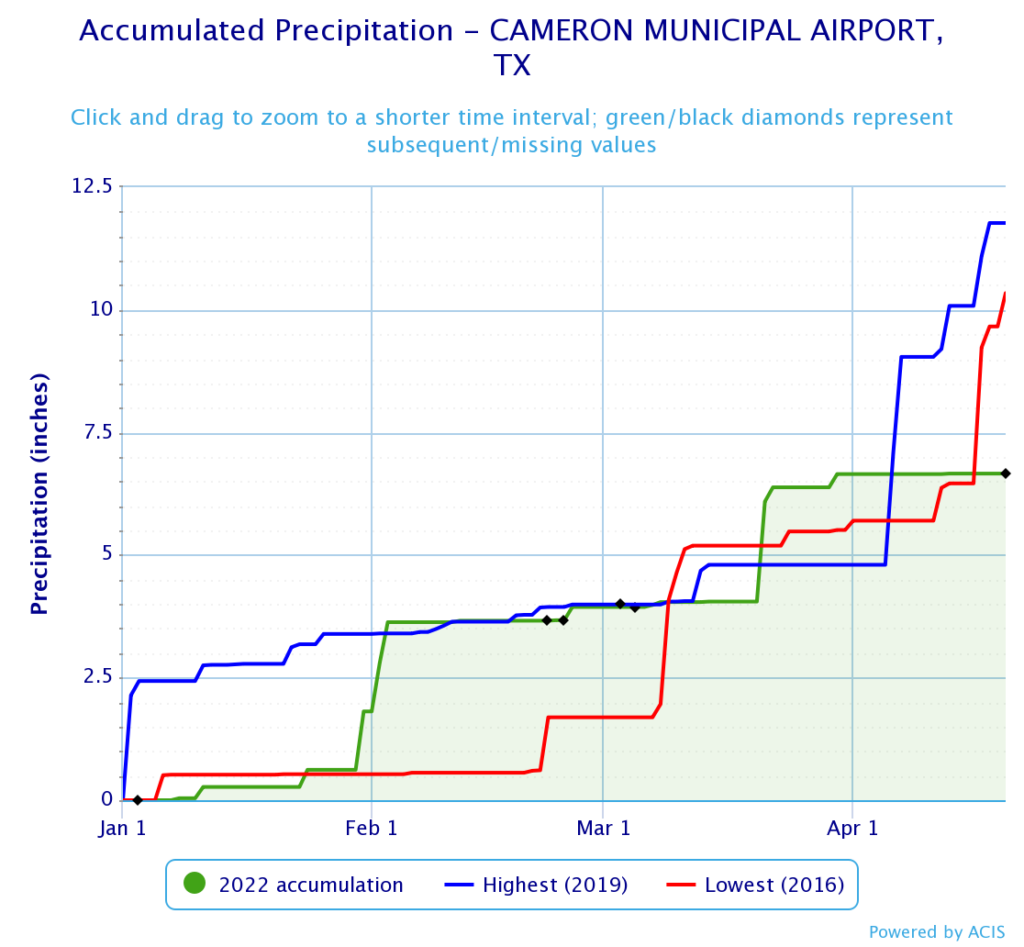
Let’s get out of Texas for a bit. We know West and North Texas are a mess. Around the nation we are seeing accumulations that are alarming. Kansas has been hit hard, for starters, as one of the worst examples:
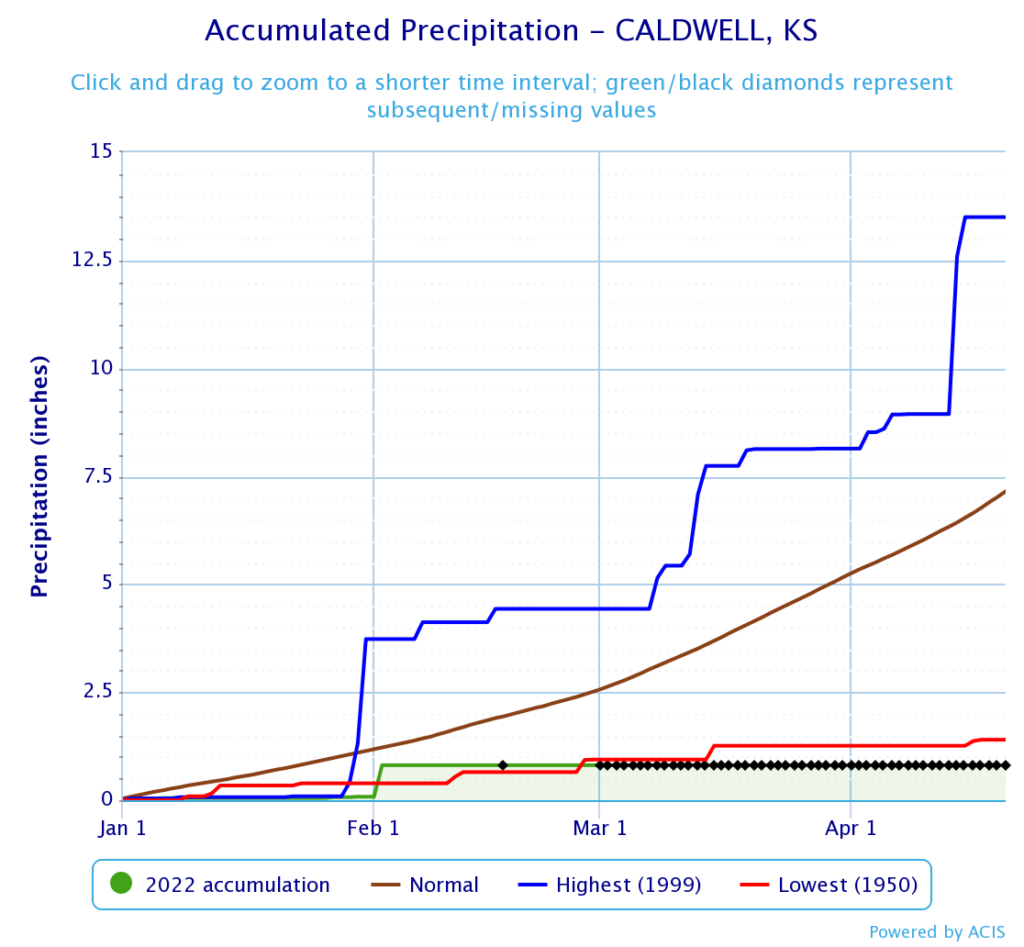
Well below anything seen recently. Nebraska hasn’t fared much better. These two are the Midwest Corn Belt, and play an important role in ag, ethanol, and general sentiment in the market.
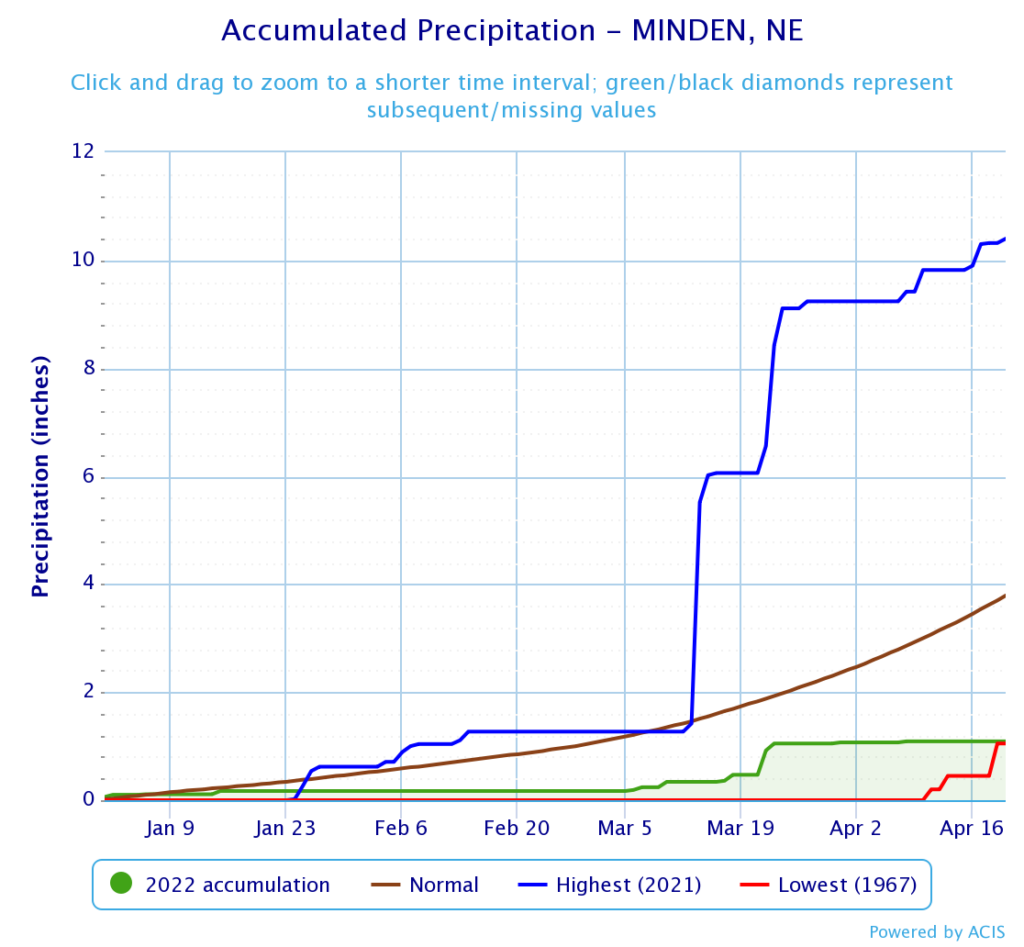
Let’s branch out a bit. North Texas. South to North it isn’t getting better. To the east, more than they need (looking at you Tennessee), to the north, it’s been snow, and then mud, making planting hard. Cattle land and Cotton capital of Texas:
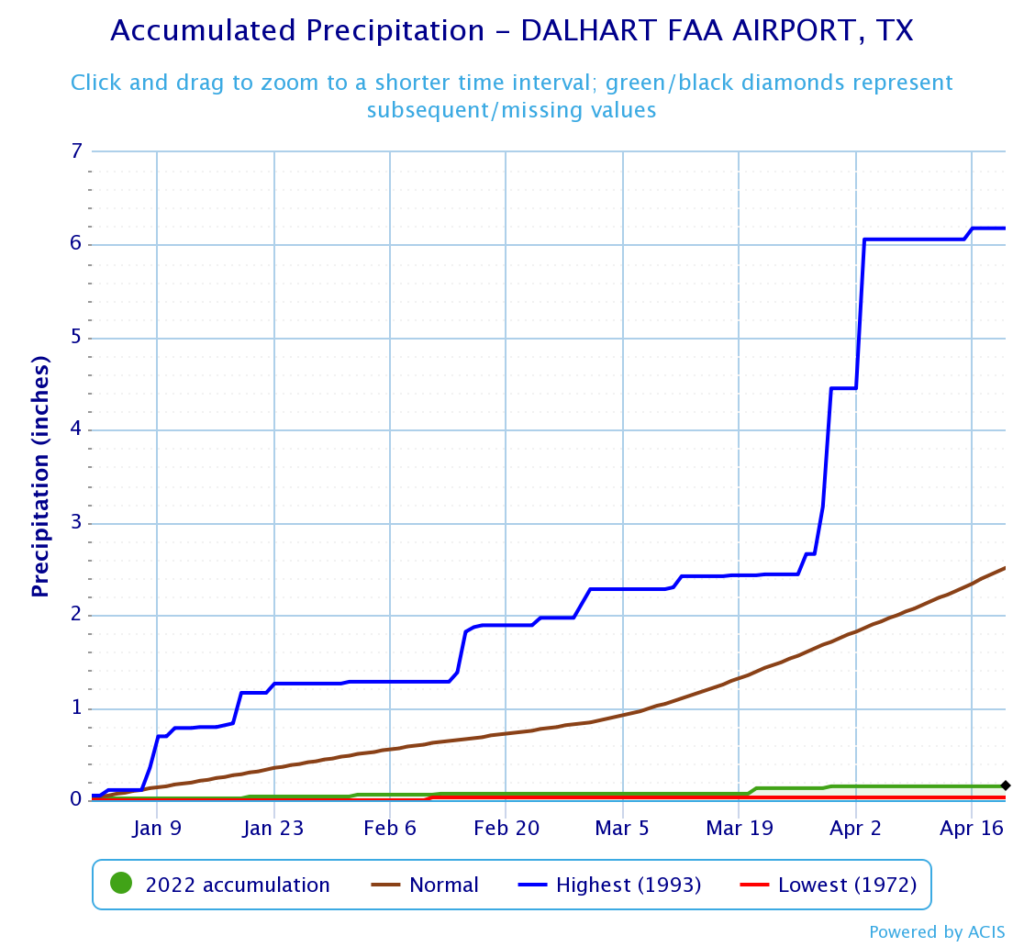
This heatmap is ten years old, but still relevant to frame the argument:
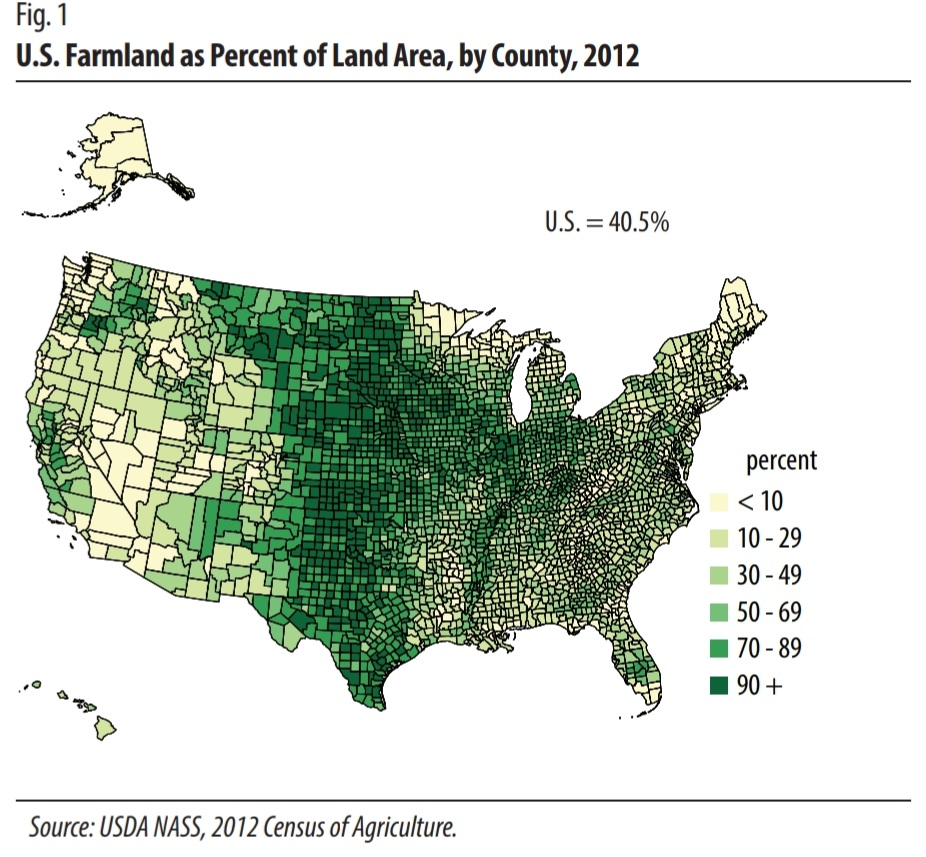
We are already seeing that crop insurance is going to be a huge factor this year in making farmers somewhat whole again, much like we saw in 2011. Current history has been consistent, future climate is less predictable. Climate change has been here, the extremes only recently felt. Irrigation helps, but we can only irrigate up to 80% of what a corn crop needs, the rest has to fall from the sky.
Unfortunately, the ENSO cold phase does not seem to be waning, even into the summer. It has been reported as of this month, that the ENSO phase is not collapsing, rather stabilizing which could complicate Winter 2022/2023. A third La Nina phase, while not unheard of, is rare, only happening twice since 1950 per NOAA.
The most significant piece to take away from the NOAA blog post by the climate scientists is this:
If the models hold, a third year would exacerbate an already deeply troubling circumstance for North America. An inch or two a month is a welcome relief, but will not make up reservoir deficits any time soon, and aquifers will not have a chance to even slightly recover. A rough road may be ahead.

On a different note from water issues, this is a channel I have been watching for a short while. He’s a small farmer and reminds me of my mom’s side of the family (dairy, veggies, apples).
In this video he talks about Community Supported Agriculture (CSA’s) how he started with them, the advantages but how he has moved on from that model. He notes the issues that came up as Covid hit.
Just a nice fun person to watch. Plus he has quips of wisdom.
My son keeps pushing me to expand on our YouTube channel and I haven’t found the time to really invest. There are a lot of great content creators out there and Peter is a great one. Lansing is beautiful.
Anywho, Peter describes some of my gripes. We first started out the first two years doing CSA and delivering to folks in the cities. The upfront costs were not fun and we made a little money those years. The pandemic energized a lot of other companies with deep pockets to essentially do the same thing. New habits are hard to form and most people went back to going to the grocery stores in Sundays much like they had done for 5+ years prior to the pandemic lock down. Vegetable farming has little margins and we are getting squeezed right now in a time where everyone wants to farm as they spent the past two years watching YouTube videos that romanticize farming and “getting back to the land”. I celebrate the folks doing it, but I also caution that farming these days is the celebrity chef movement of the 2010s. It seems glamorous, but it is actually hard work and a lot of luck.
Farmers markets have also become more than just farmers. Other ventures have now become privy to the markets and what they can do to transform small businesses. The average farmers market now has food trucks, live entertainment, bakers, jewelers, hatters, cobblers, pop up coffee shops, coffee roasters, soapers, essential oils blenders, infusers, t-shirt dyers, pant bedazzles, dog treat bakers, macrame weavers, quilters, cell phone dealers, gym membership enlisters, government officials, campaigning politicians, girl scouts, bit scouts, church groups, pet fosters, restaurants, CSA dealers, and a whole host of other vendors that have absolutely nothing to do with farming. My point is, we have sold or evaluated to sell at five markets in the past three years, two have ended up as flea markets, one got overrun with large 100+ acre producers that also have large contracts with grocers, one that we couldn’t really keep up with, and our current one that has both good and bad attributes but the board are great people and the overall vision is there.
Overall net margins are slim. Our poultry operation is negative on the egg side and the meat side, the overhead costs are up…a lot. I had a 7% grain cost increase just in March alone. The vegetable side we are competing with 40+ other farms, but most importantly national groceries buying produce from Mexico and South America. When inflation hits, the cheap wins, every time. Niche markets are the first to feel this pinch and the past few weeks as the consumers pull back has been brutal. We don’t sell out of anything anymore. The ones who do are the food trucks, cake decorators, and the soy based candle lady. Actual farmers at a farmers market…well it’s an uphill, but that’s been the case for almost 40 years.
on your last thread i complained about cold and wet soils and a delayed start to the growing season in the northern corn belt, and it hasn’t improved…yesterday the weather.gov national map had frost and freeze warnings up from northern Oklahoma to Nebraska and Iowa, and then east to Ohio….forecasts for my corner of Ohio are 33 °F tonite, 27 °F tomorrow night, 30 °F Thursday night, and 33 °F on Friday night…late this afternoon, i emptied my little unheated greenhouse and brought everything back into the house for the rest of the week..
Yes, the polar vortex is not giving up. I learned a few years ago that the warming of the planet has allowed the vortex to shift more southernly than it used to. Just watching the Weather Channel over the last few years you can see how it carves out the central part of the nation. Sometimes its a very distinct V.
Being in RI, it used to be easy to tell what weather we would have by seeing what would come from the west. Now storm seem to travel up the coast and stay toward NY and then north or will swing sharp east and stay south of us. Thus, we have been fortunate that we have not had major disasters like the central and south east.
However, this past year we have had more wind than I recall. I had an 80′ pine come down via 3 different storms (it had 3 stalks). It was not diseased and had survived a few hurricanes. We’ve also been very wet for the past year since last spring.
it’s 33 °F at 3 PM here now, & it hasn’t been much above 35 °F all day…
i think it was climate researcher Dr. Jennifer Francis of Rutgers who showed that the slowing of the polar jet stream resulted in its wavier pattern that allowed the polar vortex to dip further south more frequently, Dan…but i’m not sure that’s what’s going on here now…this strikes me as a classic La Nina winter pattern; colder & wetter than normal across the northern tier into the Great Lakes, warmer and drier across the South…
we’re in the middle of what must be an unprecedented three year string of LaNina years, and when an abnormal weather patterns persist a few years like that, we tend to start to view them as normal….the jet stream in La Nina winters crosses into the US from the Canadian maritimes, dips into the Ohio Valley, then turns north into New England…that may be why you’re seeing storms move up the coast, rather than cross the country west to east…an El Nino year, or even a relaxation of the La Nina, could flip that back..
living in the Lake Erie snow belt all my life, i’ve learned to dread an approaching LaNina winter, cause it just exacerbates all the problems that winter typically dumps on me…but i’ve paid less attention to how it impacts the weather during other seasons….with a wider variability than during winter, La Nina summers tend to be hotter in the midsection of the US and cooler on the coasts, and even drier than the winters in the Southeast…and of course, the Atlantic hurricane seasons in La Nina years tends to be worse, with more storms and larger ones, which has already been forecast for this coming year by several university climate centers..
i just realized i used the wrong expression to describe the winter path of an LaNina jet stream; the Canadian maritimes are east coast, and i mean the Canadian Pacific northwest…that jet stream enhances the observed weather; by initially moving north, then southerly, it enhances the clockwise circulation associated with high pressure, and hence the drier pattern across the western US you see above….but then when it turns back north over the Ohio valley, it enhances a counterclockwise circulation, ie, it builds an “upper level low”, which strengthens low pressure storms on the surface…
Becker and RJS,
Central VA in recent years has been getting more cool flows in spring from March through June as the warming northern polar region pushes the eastern trough of its jet stream further south with expanding rapidly warming air following the polar winter. By July the northern polar air expansion stalls and begins to recede taking the eastern trough of the polar jet stream back north with it and central VA gets baked in a southern fried oven from July through mid-September. ENSO status does not matter very much with this trend except that La Nina punctuates the baking with an occasional hurricane either with east coast landfall or just running up north from the Gulf of Mexico.
completely coincidentially (i was at this site for an article about eminent domaining farms for the CO2 pipeline complex):
What La Niña means for Iowa this summer | who13.com
La Niña has been with us all year, and it’s not showing any sign of leaving soon.
The climate pattern is favored to continue through the summer, according to an updated outlook released this week by the National Oceanic and Atmospheric Administration. There’s a 59% chance will stick around through August, and the odds are about even that it will continue past August into the fall (NOAA is giving it a 50-55% chance right now).
La Niña – and its opposite, El Niño – are characterized by the temperature of the Pacific Ocean. But they have major impacts on the weather we experience on land.
La Niña typically brings drier conditions to the southern half of the country and more precipitation to pockets of the northern half. Drought conditions often worsen, and that looks to be the case for most of the West this summer. The only exception is southern Arizona, which may see an active monsoon season.
This summer, NOAA is also forecasting above-average rainfall for Florida and for the area surrounding the Ohio Valley, including Indiana, Kentucky, Ohio, Virginia, West Virginia, Pennsylvania and more (see maps below).
La Niña winters are usually warmer in the South and cooler in the Northern states. When it comes to the summer, NOAA is predicting a hot one for just about everyone. The three-month outlook shows warm weather for all states except the Great Lakes region.
The hottest temperatures are predicted out West, in Utah, Colorado, New Mexico and Arizona.
NOAA’s three-month outlook shows expected conditions for summer 2022 under La Niña. (NOAA maps)
La Niña also has an impact on hurricane season. It typically weakens storms originating in the Pacific, but leads to stronger hurricanes in the Atlantic.
Hurricane season doesn’t usually peak until late summer, but meteorologists are already predicting a busier-than-average year for 2022. Colorado State University’s hurricane outlook calls for 19 named storms, nine of which they expect to be “major hurricanes.”
Don’t worry. In another thirty years, then now will be the good ol’ days. On the possibility of reversing climate change, then the Earth is easily forty years late to that dance.
https://www.theguardian.com/environment/2021/jul/25/gaya-herrington-mit-study-the-limits-to-growth
Yep, it’s bleak, says expert who tested 1970s end-of-the-world prediction
Edward Helmore
A controversial MIT study from 1972 forecast the collapse of civilization – and Gaya Herrington is here to deliver the bad news
t a UN sustainability meeting several years ago, an economic policy officer came up to Gaya Herrington and introduced himself. Taking her name for a riff on James Lovelock’s earth-as-an-organism Gaia hypothesis, he remarked: “Gaya – that’s not a name, it’s responsibility.”
Herrington, a Dutch sustainability researcher and adviser to the Club of Rome, a Swiss thinktank, has made headlines in recent days after she authored a report that appeared to show a controversial 1970s study predicting the collapse of civilization was – apparently – right on time.
Coming amid a cascade of alarming environmental events, from western US and Siberian wildfires to German floods and a report that suggests the Amazon rainforest may no longer be able to perform as a carbon sink, Herrington’s work predicted the collapse could come around 2040 if current trends held…
rjs,
Have you looked into forecasts regarding the effects of climate change on strong El Nino events? ENSO has us between a rock and a hard place now.
https://slate.com/technology/2018/07/james-hansens-1988-climate-change-warning-30-years-on.html
Thirty Years Warmer
In 1988, James Hansen warned the nation about climate change. Decades later, is American public opinion finally catching up?
By Madeline Ostrander
July 02, 201811:43 AM
Jeff Atkins first heard about global warming in 1988 from a news broadcast that aired on his family’s television in rural North Carolina, where his grandfather managed a small tobacco farm and worked as a carpenter. He was just 7 years old but holds a distinct memory of the time when he, along with many other Americans, became aware of a stark and enormous idea: that humans were causing a planetwide increase in temperatures and that, if nobody corrected the problem, this could trigger disastrous changes to the Earth’s climate for centuries to come.
That summer, the news filled with dire reports based on the testimony of NASA climate scientist James Hansen and the startling research findings he had just delivered to the U.S. Senate:
Loads of articles refer to the 30 years later update by Hansen. There is also more current reports from Hansen warning that the rate of temperature rise is doubling, but I could not find an ungated source on that. Dust off your Google search and then remember that advice from the cold war days when the alarm goes off to put your head between your knees and kiss your … goodbye. Look on the bright side though. WW-III nuclear war may be the only way that we have remaining to reverse climate change a la nuclear winter.
If you do Google then select your search arguments carefully. The Internet is loaded with warnings against climate change alarmists turning people off. Serious as a heart attack. Thankfully I am old enough that I will not need to put up with this much longer.
Listening to the NPR and learned about South Africa having a major flood.
“The storm, which delivered close to an entire year’s usual rainfall in 48 hours, took meteorologists by surprise and has been blamed by experts on climate change. The new disaster comes after three tropical cyclones and two tropical storms hit south-east Africa in just six weeks in the first months of this year.”
https://www.theguardian.com/world/2022/apr/24/south-africa-floods-rain-climate-crisis-extreme-weather
I wish the national news would consistently report on these major weather events that are happening all over the planet. Then, maybe people here would get the message.
Was listening to that too. It’s only going to intensify.
It really sucks when the elephant in the room is a inconvenient 400 pound gorilla.